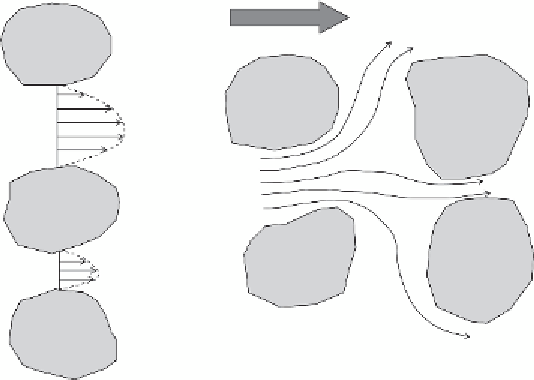Geoscience Reference
In-Depth Information
(a)
(b)
Average flow direction
Figure 5.1
(A
) Flow velocity variation within a pore. (
B
) Flow velocity variation in
the low direction due to the pore network. (After Bear and Verruijt, 1987)
The bulk transport of solutes occurs when solutes are carried along with the moving
soil water. This lux is called the
convective
lux,
J
con
(kg m
-2
d
-1
), and can be calcu-
lated using the average soil water lux
q
(m d
-1
):
J
=
C
(5.2)
con
l
In the case of water low, the Darcy lux
q
, which is averaged over a certain cross
section, is usually suficient. In the case of solute transport, we need to consider the
water velocity variation between pores of different size and geometry and even the
variation within pores (
Figure 5.1
).
These differences of water velocities cause some solutes to advance faster than
the average solute front, and other solutes to advance slower. The overall effect will
be that solute concentration differences are smoothened or dispersed. Solutes seem
to low from high to low concentrations. If the time required for solutes to mix in the
lateral direction is small compared to the time required for solutes to move in the low
direction, the
dispersion
lux
J
dis
(kg m
-2
d
-1
) appears to be proportional to the solute
gradient (Bear,
1972
):
∂
∂
C
z
J
=−
θ
D
l
(5.3)
dis
dis
with
D
dis
the dispersion coeficient (m
2
d
-1
). Note that the dispersion lux in Eq. (
5.3
)
has a mathematical expression similar to that of the diffusion lux in Eq. (
5.1
). Under

Search WWH ::

Custom Search